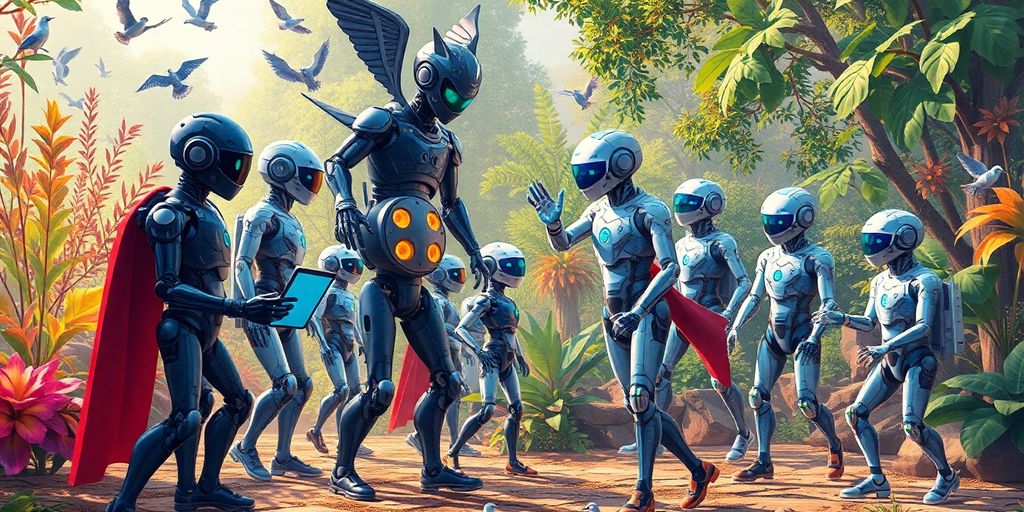AI is more than just a buzzword. It’s a whole world where agents interact with environments, making decisions and learning from their surroundings. Imagine a robot vacuum navigating a messy room or a self-driving car cruising down the highway. These AI agents perceive their environment, process information, and take actions to achieve specific goals. This article is your go-to guide for understanding how these agents work, the different types, and where they’re headed in the future.
Key Takeaways
- AI agents operate within environments, reacting to stimuli and feedback.
- There are several types of environments, each affecting how an AI agent functions.
- AI agents can be simple reflexive, model-based, goal-oriented, or utility-driven.
- Perception and action are key processes in how agents interact with their environments.
- Reinforcement learning allows AI agents to adapt and improve based on rewards and penalties.
Understanding the Agents Environment in AI
Defining the Environment
In the world of artificial intelligence, the environment is where everything happens. It’s the stage where AI agents perform and interact. Think of it as the external world that surrounds an AI system, providing the stimuli and feedback it needs to function. Without an environment, AI agents would be like actors without a stage. They wouldn’t have a context to operate in, nor any data to process.
Types of Environments
AI environments come in various shapes and sizes, each with its own set of characteristics:
- Fully Observable Environments: Here, agents get complete information about the world. They can see everything they need to make decisions.
- Partially Observable Environments: These are a bit more challenging. Agents only get limited or noisy information, requiring them to guess or infer the missing pieces.
- Deterministic Environments: Everything is predictable. The outcomes are clear, and agents can rely on specific actions leading to specific results.
- Stochastic Environments: There’s an element of randomness. Agents need to think probabilistically, considering the chance of various outcomes.
- Episodic Environments: Actions don’t have long-term consequences. Each task is independent, so agents can focus on one thing at a time.
- Sequential Environments: Actions are linked, with each one affecting future possibilities. This requires planning and foresight.
| Type of Environment | Description |
|---|---|
| Fully Observable | Complete and accurate information available to agents. |
| Partially Observable | Limited or noisy information, requiring inference and belief states. |
| Deterministic | Predictable outcomes, allowing precise decisions based on known rules. |
| Stochastic | Randomness and uncertainty, requiring probability-based reasoning. |
| Episodic | No lasting impact on future episodes, focusing on individual tasks. |
| Sequential | Interconnected states and actions, where one action influences future ones. |
Role of Environment in AI
The environment isn’t just a backdrop; it’s a crucial part of the AI’s functionality. It provides the data that AI agents need to learn and adapt. For instance, in a dynamic execution environment, AI agents can refine their outputs based on past interactions, making them more effective over time.
The environment shapes how AI agents think and act, providing the context and challenges they must navigate. Without it, AI would have no purpose or direction.
Types of AI Agents and Their Interactions with Environments

Simple Reflex Agents
Simple reflex agents operate based on the current situation, ignoring the history of past actions. These agents choose actions solely on the basis of the current percept, which makes them fast but not very intelligent. They are best suited for environments that are fully observable, where the agent has access to complete information about the environment. An example might be a thermostat that turns on heating based on the current temperature.
Model-Based Reflex Agents
Model-based reflex agents maintain an internal state to keep track of aspects of the world that are not immediately observable. This allows them to handle partially observable environments better than simple reflex agents. They use a model of the world to predict the effects of their actions, which helps them make more informed decisions. For instance, a self-driving car uses a model to understand traffic patterns and make driving decisions.
Goal-Based Agents
Goal-based agents act to achieve specific objectives. They not only consider the current state but also evaluate future states to decide which actions will lead them closer to their goals. These agents are more flexible and intelligent compared to reflex agents, as they can adapt their actions to changing goals. Think of a chess-playing AI that plans several moves ahead to achieve checkmate.
Utility-Based Agents
Utility-based agents go a step further by considering the "happiness" or "satisfaction" of different states. They aim to maximize their overall utility, which involves balancing multiple goals and preferences. These agents are ideal for complex environments where trade-offs are necessary, such as in financial trading systems where risk and reward must be balanced.
AI agents are autonomous programs capable of observing their environment, making decisions, and taking actions to achieve specific goals. They can monitor data streams and perform tasks based on the information they gather. Understanding the different types of AI agents helps in designing systems that can effectively interact with their environments.
Perception and Action: How AI Agents Navigate Their Environment
Perception Mechanisms
AI agents use perception to gather information from their surroundings, which is crucial for understanding and interacting with the world. Perception allows AI agents to sense their environment through various sensors, like cameras or infrared detectors. These sensors collect raw data, which is then processed by algorithms to form a coherent picture of the environment. This data processing is essential for the agent to make informed decisions and take appropriate actions. For instance, a robot vacuum cleaner uses sensors to detect furniture and dirt, helping it navigate and clean efficiently.
Decision-Making Processes
Once the AI agent has perceived its environment, it needs to decide what to do next. This involves analyzing the data collected and determining the best course of action. The decision-making process can range from simple rule-based systems to complex algorithms that consider multiple factors. AI agents often use decision trees or neural networks to evaluate possible actions and select the most favorable one. For example, a self-driving car must decide how to maneuver through traffic based on real-time sensor data.
Action Execution
After deciding on a course of action, the AI agent must execute it. This involves translating the decision into physical movements or commands. The execution phase is critical as it determines how effectively the agent interacts with its environment. Actuators, such as motors or robotic arms, are often used to perform the desired actions. The success of action execution relies on the accuracy and precision of both the decision-making process and the physical components involved. If a robot vacuum decides to clean a specific area, it must navigate to that spot and perform the cleaning task accurately.
AI agents rely on a seamless integration of perception, decision-making, and action execution to effectively interact with their environments. This triad forms the backbone of any intelligent system, enabling it to perform tasks with a degree of autonomy and efficiency.
Learning from the Environment: Reinforcement Learning in AI

Reinforcement learning is all about how AI agents learn by interacting with their surroundings. It’s like teaching a dog new tricks, but instead of treats, agents get virtual rewards or penalties based on their actions.
Concept of Rewards and Penalties
In reinforcement learning, agents are trained using a system of rewards and penalties. This means that when an agent makes a good decision, it gets a reward, and when it makes a bad one, it faces a penalty. Think of it like a game where the goal is to maximize the points. This system helps agents learn which actions are beneficial in the long run.
Here’s a simple way to understand it:
- Agents perform actions in an environment.
- They receive feedback in the form of rewards or penalties.
- Over time, they learn to choose actions that increase their total reward.
Markov Decision Processes
Markov Decision Processes (MDPs) provide a framework for modeling decision-making problems where outcomes are partly random and partly under the control of a decision maker. In simple terms, MDPs help AI agents decide the best course of action by considering both the current situation and the potential future consequences of their actions.
Imagine an AI-powered robot navigating a maze. It uses MDPs to decide which path to take by evaluating the potential rewards and risks of each route.
Q-Learning and Policy Iteration
Q-learning is a popular reinforcement learning technique where agents learn the best actions through trial and error. They try different strategies and remember which ones lead to success. It’s like a chess player learning the best moves by playing countless games.
Policy iteration, on the other hand, involves evaluating and refining strategies to find the most effective one. The agent continuously assesses its current strategy, makes small adjustments, and repeats this process until it finds the optimal way to achieve its goals.
Reinforcement learning is a fascinating approach that allows AI agents to improve their performance by learning from their experiences. It’s like watching a child learn to ride a bike—they fall a few times, but eventually, they figure out how to balance and pedal smoothly.
Real-World Applications of AI Agents in Various Environments
AI in Healthcare Environments
AI agents are making waves in healthcare, offering solutions that range from diagnostics to patient care. These agents can analyze complex medical data, helping doctors make informed decisions. For instance, AI-powered systems are used to interpret imaging results, like MRIs and CT scans, with impressive accuracy. They assist in identifying patterns that might be missed by the human eye, leading to earlier and more accurate diagnoses. Moreover, AI chatbots in healthcare settings provide patients with 24/7 assistance, answering queries and scheduling appointments, thus enhancing the efficiency of healthcare services.
AI in Financial Systems
The financial sector is another area where AI agents are proving invaluable. From fraud detection to algorithmic trading, these agents are transforming how financial institutions operate. AI-driven tools analyze vast amounts of transaction data to identify unusual patterns that could indicate fraudulent activity. This proactive approach significantly reduces the risk of financial loss. In trading, AI algorithms execute trades at lightning speed, leveraging market data to optimize investment strategies. Additionally, AI chatbots offer personalized financial advice, helping customers manage their finances more effectively.
AI in Autonomous Vehicles
Autonomous vehicles are perhaps the most visible example of AI agents at work. Companies like Waymo are at the forefront, developing self-driving cars that navigate complex urban environments. These vehicles rely on a suite of sensors and AI systems to perceive their surroundings, make real-time decisions, and safely transport passengers. The AI agents in these cars continuously learn from driving experiences, improving their performance over time. As technology advances, the potential for autonomous vehicles to reduce traffic accidents and improve urban mobility becomes increasingly promising.
Future Trends in AI Agents and Their Environments
Emerging Technologies
AI agents are getting smarter and more autonomous. With the rise of technologies like quantum computing and advanced neural networks, AI agents are evolving rapidly. These advancements allow agents to process information faster and make more complex decisions. Imagine an AI that can not only suggest a playlist but also compose music tailored to your mood. That’s where we’re heading.
Integration with Human Intelligence
The future isn’t just about machines working alone. It’s about AI agents and humans teaming up. This collaboration could lead to AI systems that enhance human decision-making, offering insights and suggestions in real-time. Think of it as having a super-smart assistant that helps you tackle everyday challenges, from managing your schedule to making investment decisions.
Potential Challenges and Solutions
As AI agents become more integrated into our lives, we face new challenges. Privacy concerns, ethical dilemmas, and the risk of over-reliance on technology are just a few. But with these challenges come solutions. Developing robust privacy frameworks and ethical guidelines will be crucial. Balancing innovation with responsibility will ensure AI agents contribute positively to society.
The journey of AI agents is just beginning, and the possibilities are endless. From reshaping industries to transforming daily life, AI agents are set to become an integral part of our future. The key will be ensuring they operate ethically and effectively, benefiting all of society.
Here’s a quick look at potential applications:
- AI in personal healthcare assistants
- Automated financial advisors
- Smart home management systems
These trends highlight the exciting future of AI agents and their potential to redefine how we interact with technology.
Wrapping It Up: The Role of Environments in AI
So, there you have it. We’ve taken a look at how environments shape the way AI agents work. From fully observable to stochastic, each type of environment offers its own set of challenges and opportunities for AI systems. Whether it’s a robot vacuum navigating your living room or a complex AI model making decisions in a virtual world, the environment is a key player. Understanding these dynamics isn’t just for techies—it’s something that affects how AI can be used in everyday life. As AI continues to grow, keeping an eye on how these environments evolve will be crucial. Who knows what the future holds? But one thing’s for sure: the relationship between AI agents and their environments will keep getting more interesting.
Frequently Asked Questions
What is an AI agent?
An AI agent is like a smart computer program that can see what’s around it, make choices, and do things to reach goals.
How do AI agents learn from their environment?
AI agents learn by trying things out and seeing what happens. They get rewards for good actions and penalties for bad ones, helping them figure out the best way to do things.
What are some types of AI agents?
There are different kinds of AI agents, like simple reflex agents that react to things, and goal-based agents that plan steps to reach a goal.
Can AI agents think like humans?
Not exactly. AI agents can make decisions and learn, but they don’t have feelings or thoughts like humans do.
Where are AI agents used in real life?
AI agents are used in many places, like in self-driving cars, helping doctors in hospitals, and even in games to make them more fun.
What challenges do AI agents face?
AI agents can have trouble when things are unpredictable or when they don’t have enough information to make good decisions.




